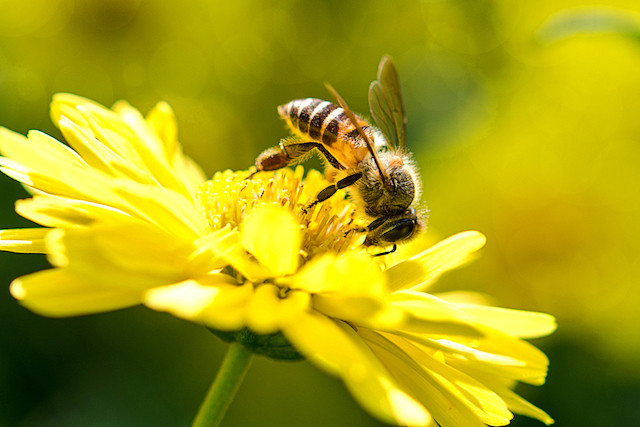Honeybees can learn to add and subtract, according to research showing that while the insects have tiny brains, they are still surprisingly clever. Researchers behind the study have previously found that honeybees can apparently understand the concept of zero, and learn to correctly indicate which of two groups of objects is the smaller. But now they say insects can learn to carry out exact numerical calculations such as adding and subtracting a given number.
“Their brain can manage a long-term rule and applying that to a mathematical problem to come up with a correct answer,” said Dr Adrian Dyer, co-author of the research from RMIT University in Australia.
“That is a different type of number processing to spontaneous quantity judgments.” If the team are right, the insects are in good company. While it was once thought that only humans could manage such calculations, the authors note recent research has revealed a veritable menagerie of creatures can keep track of numbers or even add or subtract.
“[There was] evidence that other primates could do it and then an African grey parrot, Alex, famously could do it, but also some spiders could do it,” said Dyer.
The team say the latest research adds to a growing body of evidence, including human studies, that language is not necessary for learning how to manipulate numbers. And there’s more. “It is teaching us a lot about what brains can do and what necessary structures you might need in brains to achieve certain outcomes,” said Dyer.
However, Paul Graham, professor of neuroethology at the University of Sussex, was cautious, and said it was not clear that the bees really did have a concept of mathematical operations, or even numbers. “In reality, you don’t really know what the animal has done, because you are not investigating how it is doing it,” he said, adding it was hard to design an experiment to rule out other, simpler explanations for the bees’ behaviour.
Bee maze
Writing in the journal Science Advances, Dyer and colleagues describe how their research involved releasing bees into a simple maze in which they were shown a picture of a small number of coloured shapes. After flying through a hole, the bees were presented with two further images showing a different number of shapes.
When the shapes in the set up were blue, insects that made a beeline for the image with one more shape than in the initial picture were offered a sugary drink. When the shapes were yellow, they were rewarded for flying to the image with one fewer shape. If the bee flew to the “incorrect” image, they were given a quinine solution – which is unpleasant to bees.
“It is very hard to train a bee to understand a plus or minus sign because that is an abstract symbol, so we use colour because they learn colour very quickly,” said Dyer. Fourteen bees were involved in the experiment and each completed 100 of the training exercises, with the shapes and numbers – up to a maximum of five – chosen at random from a pool of possibilities.
Each bee was then tested 10 times on two different scenarios for each colour. Crucially, the first image the bees saw in the test setups contained three shapes. Neither the number nor the particular shape used had been presented to the bees as the initial picture during training, meaning they could not choose the “correct” answer from memory. The results showed that the bees did better on the tests than chance, getting the correct answers between 64% and 72% of the time, depending on the test.
“It is not that every bee could do this [spontaneously], but we could teach them to do it,” said Dyer. Dyer said the prevalence of numerical competence across the animal kingdom was “suspicious”, leading him to believe it might be a widespread phenomenon in animals that aids survival.
However, he added it was difficult to test this, and said there was an alternative explanation – the real phenomenon is the ability to make associations and solve conundrums, rather than have or acquire numerical skills per se.
“It might be they don’t actually use this in any natural context. They just have a brain which is plastic enough to learn our problem,” he said. “Not everything we do [as humans] is essential to our survival in [terms of] evolution: playing a guitar, surfing and travelling into space are all things we can do because we have a lot of neural flexibility, we are really bright … honeybees have been around a long time and they are very good at surviving in different environments and coming up with novel solutions, and maybe that has just led to a brain that can learn this task if they need to.”
